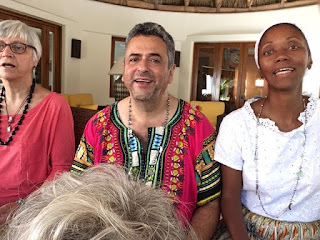SOMEbody has to be HERE in Sayulita!
Looks like I'm the designated body.
I wholeheartedly accept the task of breathing moist palpable air. Touch the air, it touches back! The sound of surf underscores birdsong and Henrique's velvet baritone as he prepares the ceremonial space for this evening's welcome when all fifteen participants will be present.
Last night several of us walked to the central plaza to see the remains of the Día de Los Muertos festivities. Sayulita is known for this grand celebration.
Imagine Tibetan prayer flags hung in rows two-feet apart across all the major dirt and cobblestone streets, only the images cut out on each colorful square are of skulls, human and animal skeletons, suns, moons, and stars. On the streets closed to vehicle traffic, mandalas of pollen, amaranth, dyed rice of all hues, and fresh flowers mirror the themes and motifs of the fluttering flags above.
Whole families are dining outside on the sidewalks. Most shops are closed as it is approaching midnight but we see through a window many statues encrusted with Huichol beaded designs. Rainbow colored horses, jaguars, and turtles.
The night is SO hot and humid, the dirt covered cobblestone one-way roads are alternately dusty and muddy since the tail of Hurricane Willa lashed Sayulita in late October.
Ana, Janaína and I linger longer in town trying to order a small taco for Janaína to taste the local flavors. It takes a L - O - N - G time. When her Brazilian tongue meets the hot Mexican chiles, I see smoke rising from her ears! Tears fill her eyes. I taste the taco. Ouch! I say to Ana, "Please tell her how courageous I think she is." When Janaína responds she says, "ALL mothers are courageous. We have to be." I think she's right and there are many more reasons ALL women are courageous and have to be. She tells me she has a daughter who is eighteen and a twenty-two-year-old son. She asks about my family. I name my beloved husband, both daughters, and the nine-year-old grandie.
Ana, who has known me for fourteen years, translates for Janaína and me. I lament that my Portuguese has rusted to the point of being creaky to virtually useless. By this time we are on the bridge walking back to Corazon, the compound where we wiłl hold ceremonies for the next two weeks. The others must have gotten back long enough ago that we three were missed because right behind us come our hosts Billie and her husband Tim in the golf cart that drove Henrique and three others of our group earlier into town.
''We were worried,'' Billie says. ''Everyone else is back so we thought we'd better make sure Ana didn't get lost again.'' We all laugh. Ann's default setting is ''lost.''
We three "lost souls" hop on the back of the golf cart. WhenTim tries to start it, nothing happens. It is as dead as my Portuguese language skills. Four strong but travel-weary women push the cart up a small hill so Tim can give it a jump start on the way down. After three such tries, we leave the fickle cart parked near the all night pizza place and the five of us walk home. It's a sweaty, steamy walk... the best antidote to cramped seat airline and bus travel.
What a perfect first day I've had!
About day seven into our two week stay, I got word from the last resident of my childhood home that Jonathan Skow died as result of injuries sustained in a surfing accident. He and his wife, clothing designer Trina Turk, purchased the John Lautner designed home from my brothers and me in 2014. They loved it from the ground up, renovating it back to Lautner's original intent: Bring Nature IN.
I'm heart-sick that Jonathan's vision, joy, and dedication to supporting the arts is taken from the world too soon. My heart aches for Trina. Together, she and Jonathan have made such a positive difference in this sometimes sad and often sorry world. I will miss him.
Here's a re-link to the NY Times article about Trina, Jonathan, and the "Long Lost Lautner."
https://www.nytimes.com/2017/06/07/fashion/lost-john-lautner-house-trina-turk.html?rref=collection/sectioncollection/fashion&action=click&contentCollection=fashion®ion=rank&module=package&version=highlights&contentPlacement=1&pgtype=sectionfront&_r=0














